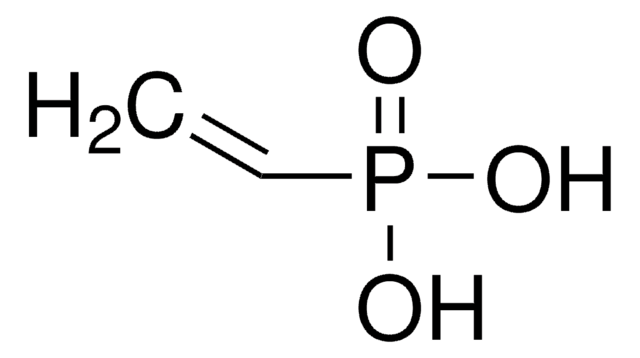695890
Phosphoric acid 2-hydroxyethyl methacrylate ester
contains 700-1000 ppm monomethyl ether hydroquinone, 90%
Synonym(s):
2-Hydroxyethyl methacrylate phosphate
About This Item
Recommended Products
description
~25% diester content
Assay
90%
form
liquid
contains
700-1000 ppm monomethyl ether hydroquinone
refractive index
n20/D 1.4688
density
1.37 g/mL at 25 °C
storage temp.
2-8°C
InChI
1S/C6H10O3.H3O4P/c1-5(2)6(8)9-4-3-7;1-5(2,3)4/h7H,1,3-4H2,2H3;(H3,1,2,3,4)
InChI key
POLZHVHESHDZRD-UHFFFAOYSA-N
General description
Application
Signal Word
Danger
Hazard Statements
Precautionary Statements
Hazard Classifications
Acute Tox. 4 Oral - Eye Dam. 1 - Met. Corr. 1 - Skin Corr. 1B - STOT SE 3
Target Organs
Respiratory system
Storage Class Code
8A - Combustible corrosive hazardous materials
WGK
WGK 3
Flash Point(F)
293.0 °F - open cup
Flash Point(C)
145 °C - open cup
Personal Protective Equipment
Certificates of Analysis (COA)
Search for Certificates of Analysis (COA) by entering the products Lot/Batch Number. Lot and Batch Numbers can be found on a product’s label following the words ‘Lot’ or ‘Batch’.
Already Own This Product?
Find documentation for the products that you have recently purchased in the Document Library.
Customers Also Viewed
Our team of scientists has experience in all areas of research including Life Science, Material Science, Chemical Synthesis, Chromatography, Analytical and many others.
Contact Technical Service![Bis[2-(methacryloyloxy)ethyl] phosphate](/deepweb/assets/sigmaaldrich/product/structures/128/336/4e7a3e38-338c-423e-95b8-70d9d1f8e121/640/4e7a3e38-338c-423e-95b8-70d9d1f8e121.png)
![[2-(Methacryloyloxy)ethyl]dimethyl-(3-sulfopropyl)ammonium hydroxide 95%](/deepweb/assets/sigmaaldrich/product/structures/217/219/73c91e1c-0ee4-4b3d-bead-a6dc3d09d1da/640/73c91e1c-0ee4-4b3d-bead-a6dc3d09d1da.png)











